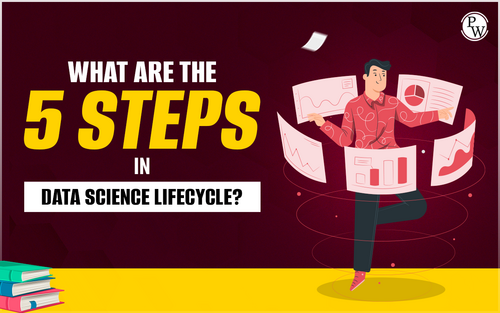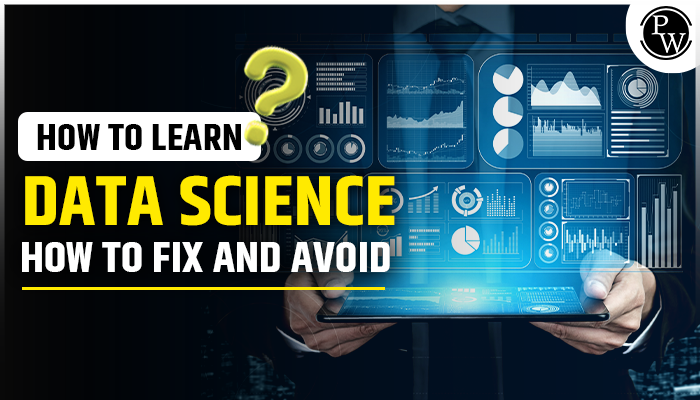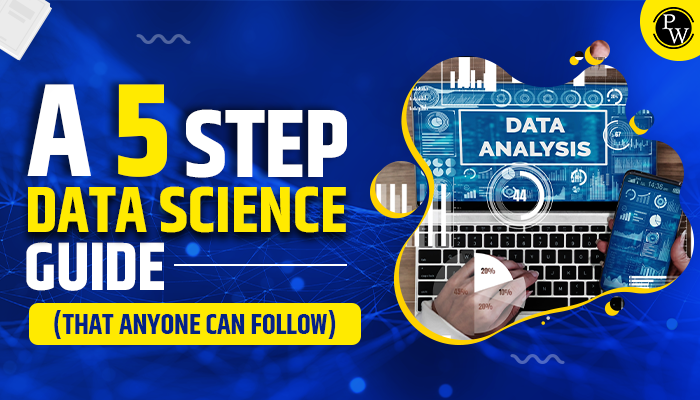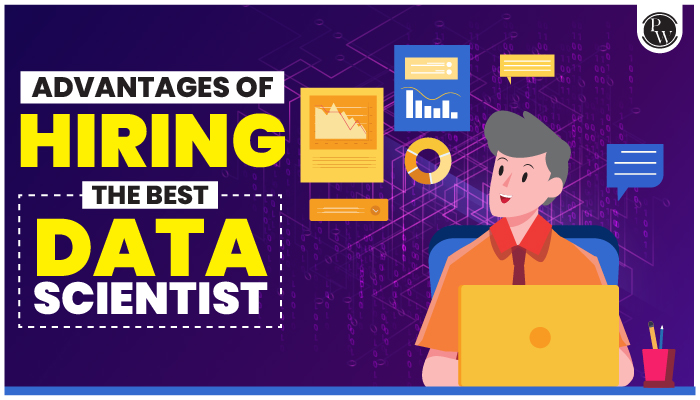Data Science Lifecycle: The world of data science is highly dynamic and constantly evolving. Data science is responsible for breaking down raw data into actionable insights that companies use to their advantage. However, understanding the different steps of the data science life cycle is paramount! So, in this blog, we’ll talk about the data science life cycle, its importance, the different stages, and much more!
If you’re looking to start a successful career in data science, then a Full-Stack Data Science course could prove really beneficial to you!
What Is the Data Science Lifecycle?
The data science life cycle is a structured guide for extracting insights from data, leading data scientists through the entire project. It starts with forming questions and goes through stages to model deployment and result communication. The Lifecycle isn’t a fixed model; it adapts to organisational needs, project specifics, and analysis goals. A standard framework features seven key steps, ensuring a systematic approach to data-driven problem-solving.
Read more: What is Data Science Lifecycle, Applications, Prerequisites and Tools
Why Is Data Science Important?

The Explosion of Data
The online world sees a massive surge in data like never before. The internet, social media, and smart gadgets create a huge amount of info known as Big Data. Dealing with and understanding this vast data set is a big task, and Data Science tackles it with analysis and prediction.
Big Data is not just a tech problem; it’s a crucial strategy. Organisations that use data effectively get a competitive advantage. They can uncover hidden patterns, identify trends, and make data-driven decisions that propel them ahead in the market.
Business Intelligence and Competitive Edge
Data Science goes beyond data management; it’s about uncovering valuable insights that drive business intelligence. Using data analytics, businesses can grasp customer behaviour, market trends, and operational efficiency. This, in turn, empowers organisations to make informed decisions, optimise processes, and stay ahead in a rapidly changing business environment.
Data Science Lifecycle PDF
One intriguing aspect of the Data Science Lifecycle is its adaptability to different documentation formats. Among these, the use of PDFs has gained popularity as a means of encapsulating the entire lifecycle in a single, shareable document. A Data Science Lifecycle PDF serves as a comprehensive guide that can be easily distributed across teams, fostering collaboration and ensuring that all stakeholders are on the same page.
But why choose a PDF for documenting the Data Science Lifecycle?
The answer lies in its versatility. A PDF document retains its formatting across different platforms, making it an ideal choice for sharing complex information, such as the detailed steps and methodologies involved in data science projects. Additionally, a PDF document can embed multimedia elements, such as images and charts, enhancing the overall understanding of the life cycle.
Moreover, the portability of PDFs ensures that the document can be accessed and reviewed offline, a crucial feature for teams working in diverse locations or with intermittent internet connectivity. Whether you are a data scientist presenting findings to non-technical stakeholders or a project manager overseeing the progress of a data science initiative, a well-constructed Data Science Lifecycle PDF can serve as a valuable reference and communication tool.
Feel free to continue expanding each section according to the subheadings and the outline provided earlier. Each subheading can be explored in detail, incorporating relevant examples, case studies, and practical insights to make the article comprehensive and informative.
Data Science Life Cycle at Javatpoint
To gain a deeper understanding of the Data Science Lifecycle, it’s valuable to explore how different organisations approach and implement it. Javatpoint, a well-known platform for Java programming and related technologies, offers insights into their perspective on the Data Science Lifecycle.
Javatpoint recognizes the importance of a structured approach in the realm of data science. Their interpretation of the Data Science Lifecycle aligns with industry best practices, emphasising the need for a well-defined process from data collection to model deployment. By examining Javatpoint’s insights, we can glean valuable lessons and potentially adopt practices that align with their successful approach. Javatpoint’s contribution to the discourse on the Data Science Lifecycle provides a practical lens through which we can view the integration of theory into real-world applications. It serves as a testament to the adaptability of the Data Science Lifecycle across different domains and organisations.
Data Science Lifecycle in Python
Python stands out in data science, thanks to its adaptability, rich libraries, and a supportive community. Understanding Python’s role in the Data Science Lifecycle is vital for practitioners aiming to utilise its capabilities for effective data analysis and modelling. In the Data Science Lifecycle, Python isn’t merely a programming language; it forms an ecosystem with numerous tools and libraries for each lifecycle phase. Whether it’s data wrangling with pandas or machine learning with scikit-learn, Python provides a seamless, integrated environment for data scientists to work efficiently.
Let’s delve into each phase of the Data Science Lifecycle in the context of Python:
- Data Collection and Cleaning: Python’s pandas library is instrumental in handling data at this stage. It provides powerful data structures for efficient data manipulation and analysis. Additionally, tools like NumPy complement pandas for numerical operations.
- Exploratory Data Analysis (EDA): Libraries such as Matplotlib and Seaborn make visualising data straightforward. Jupyter Notebooks, an interactive computing environment, further enhance the exploratory data analysis process, allowing for a step-by-step examination of the data.
- Feature Engineering: Python provides a host of libraries for feature engineering, including Scikit-learn and Feature-engine. These tools assist in transforming raw data into a format suitable for model training.
- Model Building and Training: Scikit-learn stands out as a comprehensive machine learning library in Python. Its simplicity and extensive documentation make it a go-to-choice for implementing various machine learning algorithms.
- Model Evaluation and Fine-Tuning: Python offers tools such as Scikit-learn and Statsmodels for model evaluation. Grid search and randomised search techniques help fine-tune model hyperparameters, optimising performance.
- Model Deployment: Flask and Django, popular web frameworks in Python, facilitate the deployment of machine learning models as web services. This integration ensures seamless interaction between models and applications.
- Communication of Results: Python’s visualisation libraries, coupled with Jupyter Notebooks, enable data scientists to create compelling visualisations and narratives, making it easier to communicate findings to diverse audiences.
Understanding Python’s role in each phase of the Data Science Life cycle empowers practitioners to leverage the language’s strengths and create robust, end-to-end data science solutions.
7 Stages of Data Science Life cycle
1. Problem Definition
The inception of any successful data science project lies in a clear and precise definition of the problem at hand. This stage involves collaboration between data scientists and stakeholders to identify and articulate the business objectives. The key is to translate high-level goals into specific, measurable, and achievable tasks. Without a well-defined problem, subsequent steps in the Data Science Life cycle lack direction and purpose.
Collaborative Stakeholder Engagement
Engaging with stakeholders is a collaborative effort, where data scientists seek to understand the intricacies of the business problem. This involves conducting interviews, workshops, and discussions to ensure that the identified problem aligns with the overall strategic goals of the organisation.
Goal Formulation
Once the problem is identified, the next crucial step is to formulate clear and measurable goals. These goals serve as the foundation for subsequent decision-making, guiding the entire data science team throughout the project. Ambiguity at this stage can lead to misaligned efforts and an ineffective data science solution.
2. Data Collection
With the problem clearly defined, the focus shifts to gathering relevant data. Data collection involves sourcing information from various repositories, databases, APIs, or external datasets. The choice of data sources is critical, as it directly influences the quality and applicability of the subsequent analysis.
Comprehensive Data Sourcing
Data scientists must cast a wide net to ensure they capture all relevant information. This might involve collaborating with different departments within the organisation, integrating data from third-party sources, or utilising publicly available datasets. The goal is to create a comprehensive dataset that provides a holistic view of the problem.
Quality Assurance
Ensuring the quality of the collected data is paramount. Data may be prone to errors, inconsistencies, or missing values. Rigorous quality assurance processes, including data validation and verification, are implemented to guarantee the reliability of the dataset.
3. Data Cleaning and Preprocessing
Raw data is seldom ready for analysis. Data cleaning and preprocessing involve transforming the raw dataset into a usable format. This phase addresses issues such as missing values, outliers, and inconsistencies, ensuring that the data is suitable for further analysis.
Imputation and Handling Missing Values
Missing data can significantly impact the accuracy of models. Imputation techniques, such as mean imputation or predictive modelling, are applied to estimate and fill in missing values. This step is critical to maintain the integrity of the dataset.
Standardisation and Normalisation
Data often comes in different units or scales. Standardisation and normalisation techniques are employed to bring all variables to a common scale, preventing any particular feature from dominating the analysis due to its magnitude.
4. Exploratory Data Analysis (EDA)
The Exploratory Data Analysis (EDA) phase is where data scientists dive deep into the dataset, unravelling its patterns, trends, and characteristics. This phase employs statistical analysis and visualisation techniques to gain insights that will inform subsequent modelling decisions.
Statistical Analysis
Descriptive statistics, inferential statistics, and other statistical measures are applied to understand the central tendencies, dispersions, and correlations within the data. This quantitative analysis lays the groundwork for more advanced modelling techniques.
Visualisation Techniques for Insight Generation
Data visualisation is a powerful tool for communicating complex patterns in a digestible form. Graphs, charts, and dashboards help in identifying trends, outliers, and potential relationships within the data. Visualisation not only aids the data scientist but also facilitates communication with non-technical stakeholders.
5. Model Building
Data scientists, armed with deep insights, construct models. These models unveil patterns, predict, and classify data. Selecting suitable algorithms hinges on the problem and data traits.
Algorithm Selection
Picking the correct algorithm is crucial, contingent on the issue, data type, and goal. Options include classification, regression, clustering, and deep learning.
Data Splitting for Training and Testing
Performance assessment involves splitting the dataset into training and testing sets. The model trains on the former and validates on the latter, ensuring adaptability to fresh, unseen data.
6. Model Evaluation
The effectiveness of the model is assessed using various metrics that measure its accuracy, precision, recall, and other performance indicators. This step involves thorough testing to ensure that the model meets the predefined goals and provides valuable insights.
Performance Metrics
Different types of problems demand different metrics for evaluation. For instance, a classification problem might use accuracy, precision, recall, or F1-score, while a regression problem might use mean absolute error or R-squared. The choice of metrics depends on the project’s specific objectives.
Iterative Refinement of Models
Model evaluation is not a one-time task; it is an iterative process. If the model falls short of expectations, data scientists go back to previous stages, adjust parameters, or even reconsider the algorithm choice. This iterative refinement is crucial for achieving optimal model performance.
7. Deployment and Maintenance
A successful model doesn’t end its journey with evaluation; it is deployed into production to make real-time predictions or aid decision-making. This step involves implementing the model into the existing system, making it accessible to end-users.
Implementation into Production
Deploying a model into production involves integrating it into the organisation’s existing infrastructure. This might include embedding the model into a software application, connecting it to a web service, or incorporating it into a larger analytics pipeline.
Continuous Monitoring and Updating
Once deployed, the model requires continuous monitoring to ensure its ongoing relevance and accuracy. Changes in the underlying data distribution, shifts in user behaviour, or other external factors may necessitate updates to the model. This continuous feedback loop ensures that the model remains a valuable asset to the organisation.
Also Check: Data Engineer vs. Data Scientist: What’s the Difference?
Challenges in the Data Science Life cycle
Ethical Considerations
As data plays an increasingly central role in decision-making, ethical considerations become paramount. Privacy concerns, the responsible use of data, and addressing biases in algorithms are crucial aspects of ethical Data Science.
Privacy Concerns
The collection and analysis of personal data raise significant privacy concerns. Striking a balance between extracting valuable insights and protecting individuals’ privacy is an ongoing challenge in the Data Science community.
Bias and Fairness in Models
Algorithms are only as unbiased as the data they are trained on. If historical data reflects existing biases, models may perpetuate and even exacerbate those biases. Ensuring fairness in algorithms requires careful consideration and proactive measures.
Technological Challenges
The rapid pace of technological advancement presents its own set of challenges.
Keeping Up with Rapid Technological Advances
The tools and techniques used in Data Science evolve at a rapid pace. Staying abreast of the latest technologies and methodologies is essential for Data Scientists to remain effective in their roles.
Scalability and Performance Issues
As datasets grow in size, scalability becomes a significant concern. Ensuring that models and algorithms can handle large volumes of data without compromising performance is an ongoing challenge, especially in the era of Big Data.
Data Science Lifecycle Example
To provide a tangible understanding of the Data Science Lifecycle, let’s explore a real-world example where these principles are applied to address a specific problem. Suppose a retail company wants to optimise its inventory management by predicting future demand for various products. Applying the Data Science Lifecycle to this scenario would involve the following steps:
Problem Definition and Planning
Problem: Predict future demand for products to optimise inventory management.
Objectives: Minimise stockouts, reduce excess inventory, and improve overall supply chain efficiency.
Planning: Develop a project plan outlining data sources, timelines, and key milestones.
Data Collection and Preparation
Sources: Gather historical sales data, customer purchase records, and relevant external factors like holidays or promotions.
Cleaning: Address missing data and outliers, ensuring data integrity.
Storage: Organise the data in a structured manner for easy access.
Exploratory Data Analysis (EDA) and Feature Engineering
EDA: Analyse sales trends over time, identify seasonality, and explore correlations between sales and external factors.
Feature Selection: Choose relevant features such as product category, pricing, and promotional events.
Transformation: Normalise sales data and encode categorical features.
Model Building and Evaluation
Algorithm Selection: Choose a time-series forecasting algorithm, such as ARIMA or Prophet.
Training: Train the model using historical data.
Evaluation: Assess the model’s performance using metrics like Mean Absolute Error (MAE) or Root Mean Squared Error (RMSE).
Deployment, Monitoring, and Communication
Deployment: Integrate the forecasting model into the company’s inventory management system.
Monitoring: Implement a system to monitor forecast accuracy and adjust the model as needed.
Communication: Regularly communicate insights and recommendations to stakeholders through reports and presentations.
This example illustrates how the Data Science Lifecycle provides a structured and systematic approach to solving real-world problems. By following these steps, the retail company can make informed decisions, optimise inventory levels, and enhance overall operational efficiency.
Must Read: Why choose PW for the Data Science Certification Course
Conclusion
The Data Science Lifecycle offers a systematic and adaptable framework for extracting insights from data efficiently. Whether documented in a PDF, implemented at Javatpoint, executed in Python, distilled into five steps, exemplified through real-world scenarios, or conceptualised as stages, this lifecycle provides a structured approach applicable to diverse contexts. By mastering and applying its principles, practitioners can confidently navigate data science projects, ensuring that derived insights contribute to informed decision-making and organisational success in the data-driven era.
Embrace the future of data science with the PW Skills Full Stack Data Science Pro Course. Our cutting-edge curriculum, hands-on projects, and job assurance program will prepare you for success in this rapidly growing field. Enrol today and start your journey to a rewarding and fulfilling career in data science!
FAQs
What is the role of time-series forecasting algorithms in the Data Science Lifecycle?
Time-series forecasting algorithms predict trends over time, crucial for future demand predictions.
How can animations be beneficial in a Data Science Lifecycle PPT?
Animations reveal information gradually, aiding audience engagement and illustrating the flow of activities.
Can you provide an example of a monitoring system in the context of model deployment?
A monitoring system tracks real-time model performance, alerting stakeholders to issues.
Why is it essential to continuously communicate results in the Data Science Lifecycle?
Continuous communication keeps stakeholders informed and allows adjustments based on feedback.
How does a real-world example enhance understanding of the Data Science Lifecycle?
Real-world examples demonstrate practical applications of the lifecycle, showing how each step contributes to solving specific problems.
Why is the Communication and Feedback stage crucial in the Data Science Lifecycle?
Effective communication ensures stakeholder understanding, and feedback drives continuous improvement.
How does the concept of stages differ from the steps in the Data Science Lifecycle?
Steps are sequential, while stages offer a conceptualization of distinct phases with specific characteristics.
Can you provide additional insights into the concept of stages in the Data Science Lifecycle?
Stages encompass broader categories, providing a strategic perspective on the data science journey.
What types of questions should be addressed during the Discovery and Planning stage?
Questions should focus on problem definition, goal-setting, and collaborative planning with stakeholders.
How can Python be used for real-time monitoring in the context of the Deployment and Monitoring stage?
Python offers frameworks like Flask or FastAPI for developing web services enabling real-time monitoring.




